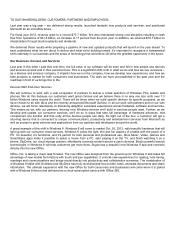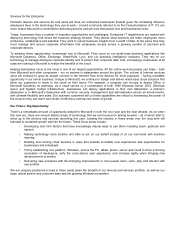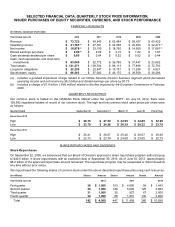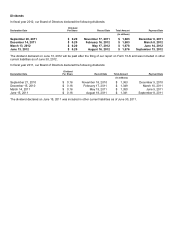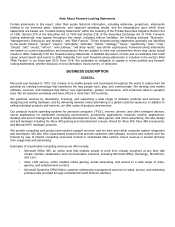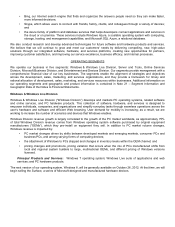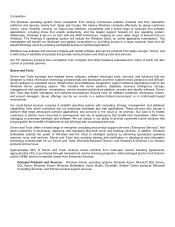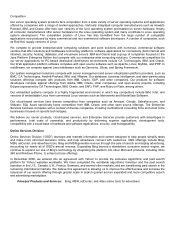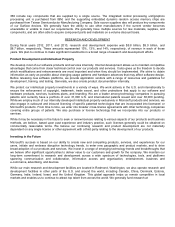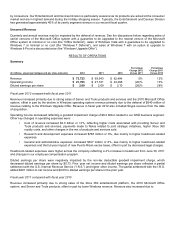Microsoft 2012 Annual Report Download - page 12
Download and view the complete annual report
Please find page 12 of the 2012 Microsoft annual report below. You can navigate through the pages in the report by either clicking on the pages listed below, or by using the keyword search tool below to find specific information within the annual report.Competition
OSD competes with Google and a wide array of websites and portals that provide content and online offerings to end
users. Our success depends on our ability to attract new users, understand intent, and match intent with relevant content
and advertiser offerings. We believe we can attract new users by continuing to offer new and compelling products and
services and to further differentiate our offerings by providing a broad selection of content and by helping users make
faster, more informed decisions and take action more quickly by providing relevant search results, expanded search
services, and deeply-integrated social recommendations.
Microsoft Business Division
Microsoft Business Division (“MBD”) offerings consist of the Microsoft Office system (comprising mainly Office, Office 365,
SharePoint, Exchange, and Lync) and Microsoft Dynamics business solutions, which may be delivered either on premise
or as a cloud-based service. The Microsoft Office system is designed to increase personal, team, and organization
productivity through a range of programs, services, and software solutions and generates over 90% of MBD revenue.
Growth in Office depends on our ability to add value to the core Office product set and to continue to expand our product
offerings in other areas such as content management, enterprise search, collaboration, unified communications, and
business intelligence. Microsoft Dynamics products provide business solutions for financial management, customer
relationship management (“CRM”), supply chain management, and analytics applications for small and mid-size
businesses, large organizations, and divisions of global enterprises.
Approximately 80% of MBD revenue is generated from sales to businesses, which includes Microsoft Office system
revenue generated through volume licensing agreements and Microsoft Dynamics revenue. Revenue from sales to
businesses generally depends upon the number of information workers in a licensed enterprise and is therefore relatively
independent of the number of PCs sold in a given year. Approximately 20% of MBD revenue is derived from sales to
consumers, which includes revenue from retail packaged product sales and OEM revenue. This revenue generally is
affected by the level of PC shipments and by product launches.
Principal Products and Services: Microsoft Office; Microsoft Exchange; Microsoft SharePoint; Microsoft Lync;
Microsoft Office Project and Office Visio; Microsoft Dynamics ERP and Dynamics CRM; Microsoft Office 365, which
is an online services offering of Microsoft Office, Exchange, SharePoint, and Lync; and Microsoft Office Web Apps,
which are the online companions to Microsoft Word, Excel, PowerPoint, and OneNote.
Competition
Competitors to the Microsoft Office system include software application vendors such as Adobe, Apple, Cisco, Google,
IBM, Oracle, SAP, and numerous Web-based competitors as well as local application developers in Asia and Europe.
Apple distributes versions of its application software products with various models of its PCs and through its mobile
devices. Cisco is using its position in enterprise communications equipment to grow its unified communications business.
IBM has a measurable installed base with its office productivity products. Google provides a hosted messaging and
productivity suite that competes with the Microsoft Office system. Web-based offerings competing with individual
applications can also position themselves as alternatives to Microsoft Office system products. We believe our products
compete effectively based on our strategy of providing powerful, flexible, secure, easy to use solutions that work well with
technologies our customers already have and are available on a device or via the cloud.
Our Microsoft Dynamics products compete with vendors such as Oracle and SAP in the market for large organizations
and divisions of global enterprises. In the market focused on providing solutions for small and mid-sized businesses, our
Microsoft Dynamics products compete with vendors such as Infor and Sage. Additionally, Salesforce.com’s on-demand
CRM offerings compete directly with Microsoft Dynamics CRM Online and Microsoft Dynamics CRM’s on-premise
offerings.


